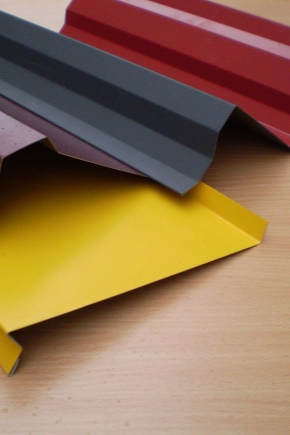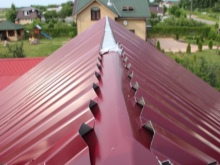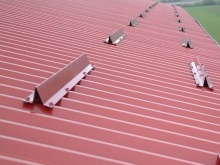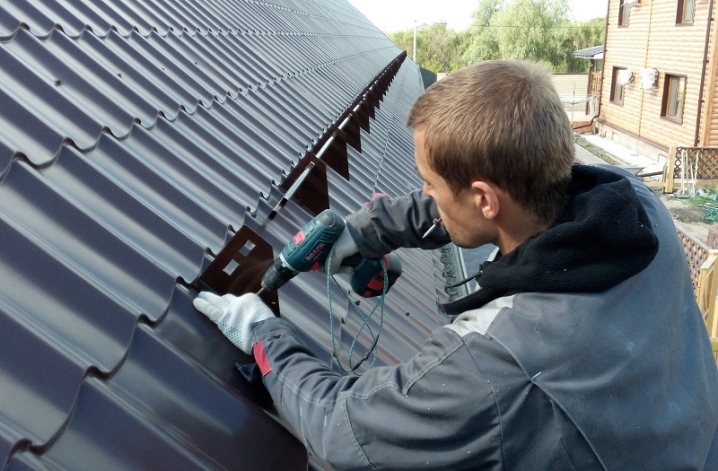Complementary elements for corrugated board

Additional elements are galvanized steel products used for roofing and other construction work.

Peculiarities
Additional elements for corrugated board have a number of features, among which the following should be noted.
-
Ease of installation (the process of installing additional elements is quite simple due to the uncomplicated device of the structure itself).
-
The cheapness of the material (also based on the most "dumb" design of the elements).
-
Performing many functions (for example, protecting against moisture, preventing heat from escaping from under the roof, providing aesthetic pleasure to the user).
In addition, it is worth adding to the last point that additional elements perform not only a protective and decorative role, but also do a good job with the distribution of air flows under the roof. In this case, the correct removal of cold and warm air masses is ensured, due to which the condensate simply does not have time to accumulate.



Views
Profiled steel sheets, like metal shingles, require a single style of manufacturing elements for accessories. As a matter of fact, at the factory, the manufacturer first cut out the required material, and then bends it. Interestingly, the thickness parameter decreases by about 3 times after such procedures. Consequently, this greatly affects the appearance of the finished product, which is why they begin to divide it into groups and come up with various technical purposes.
Addons are produced in two orders: individual (cheap, but often requires adjustment to the dimensions of the future structure) and in-line (more expensive, but much more convenient in installation, the master is given almost complete freedom of action). Most of the additional elements used in the installation of corrugated roofing are installed at the final stages. However, some components are installed only before the corrugated sheets are fixed. Therefore, you should familiarize yourself with the specifics of the materials used before starting construction work, otherwise you can get not the best quality and aesthetically good result.
The main types of roof accessories are as follows

Dropper
The most important addition used in the arrangement of a metal roof. Masters recommend using such an extension due to the different temperature conditions in the rafter system and the main covering. The installation process itself is carried out at an early stage, when the frame of the future roof is just beginning to appear. A drip is laid on top of the waterproofing layer, which is why it receives excellent heat-conducting and moisture-wicking properties. Also, using a drip, you significantly extend the service life of the future roof supporting structure. Condensate is discharged through special narrow paths located in the drip chamber.
Therefore, in the absence of an individual drainage system, it is imperative to install a drip, thus protecting your home as much as possible.



End
These are structural elements of a structure that are capable of forming an angle (more often straight) at their junction. The result is the most simple joining of two slopes or wall covering. As a matter of fact, The valley is a key node in the construction of the entire roofing system. Such an element perfectly copes with the removal of atmospheric precipitation that fell on the corresponding slopes.
Although this increases the maximum possible load on the roof, the ends are incredibly good at protecting the roof from most factors: rain, snow, sunlight.


Abutment strips
Such a simple combination of words denotes a longitudinal element that plays a concomitant role in the structure of the roof. It protects the frontal boards from adverse weather conditions (wind, snow, rain). The upper abutment bar contributes to the maximum sealing of the joints between the corrugated sheets (metal tiles) and the front elements.
Such an extension is most often used in cases where it is necessary to bring a pipe to the roof, ensuring the safety and aesthetics of the entire structure.



Eaves planks
Such an element of the roofing system most reliably and effectively protects the crate from moisture penetration into it. Installed close to the drain to ensure high-quality drainage of liquid masses. Cornice strips are used in 90% of cases, and their main material is steel. The process of applying protective layers is similar to the process of manufacturing profiled sheets and metal tiles, so you definitely don't need to worry about the quality of the finished product. It turns out that the cornice strip on both sides is covered with anti-corrosion protection: zinc, primer and polymer coating on the front side, as well as a protective varnish.
As mentioned above, the curtain rail prevents water from entering the battens and other important elements of the roof structure. In windy weather, such an element allows you to maintain the maximum thermal package inside the roof. If you neglect the rules and do not install the cornice bar, then the moisture will cause the frontal board and the crate to gradually rot. Water will start to hit the walls of the house, the side wind will almost completely blow through the space under the roof.



End strips
The most typical element of roofing, characterized by high protective properties. End strips "protect" the under-roof space from excess wind, debris and other troubles. The second no less important function of the end strip is decorative. This structural element covers the cut edges of the roof, giving the roof a finished look.
The end strip is made of profiled sheet and metal tiles, thanks to which it turns out to be incredibly strong and beautiful. The base of the plank is always covered with several protective layers, including: zinc (provides protection against rust), a passivating layer (thin surface film), primer (improves adhesion for better "connection" with polymers, protects steel from corrosion) and a finishing layer (performs decorative function, does not allow the material to wear out quickly).



Ridge strips
This element of the roof structure performs a protective function, sealing various joints on the roof surface. Correctly selected ergonomics also made it possible to create a normal air exchange in the space under the roof. Based on the name, it can be understood that the ridge is the uppermost part of the roof, therefore it is mounted last after the correct and reliable installation of the remaining additional elements. The level of tightness of the structure as a whole and the overall durability of the project being created depend on how correctly the installation of the ridge strip is carried out.
More openly and broadly, the ridge strips are mounted at the joints of the sheets of the material used along the ridge line and the outer fractures of the roof. This type of additional elements reliably protects the under-roof space from the ingress of water, dirt, insects, birds and other external factors into it.
Along with this, air is provided from the under-roof space, starting its ventilation and timely elimination of condensate.



Snow holders
This is, as you might guess, components for keeping snow from avalanche-like collapses. The possibility of installing snow guards is available on all metal roofs. Such accessories perfectly protect home owners from various situations.
In addition, snow retainers prevent damage to gutters and other property at risk.



How to calculate?
Before starting to calculate the future consumption of additional elements, it is necessary to correctly calculate the volume of the profiled sheet itself - this is the most important rule. This material is used exclusively on pitched roofs where the slope angle is greater than 15 degrees. In other cases, such construction work can bring unnecessary problems, one of which is the accumulation of vapors and their further transformation into water, which is harmful for profiled metal.
To determine the exact consumption of material for a ventilated facade, a number of factors must be taken into account: slope angle, the number of all slopes, their depth, the amount of overlap. Therefore, with a slope of 30 degrees and higher, you should pay attention to the fact that the overlap will be at least 10 cm, with a slope of only 12 degrees - more than 20 cm. The need and amount of additions are calculated based on the area of the future roof and the linear dimensions of the addition elements. It is important to remember that almost the entire set is mounted with an overlap indicator of 10 cm, and the valley - from 20 cm.
Many more experts recommend taking into account the depth of the "wave", which characterizes the material itself, the thickness of the sheet and the presence of stiffeners. You should not save a lot of material by creating an increased slope of the roof - unnecessary moisture will be guaranteed to accumulate on it, leading to rust and excessive condensation.














The comment was sent successfully.